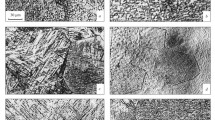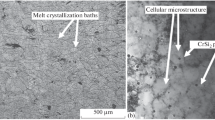Conclusions
-
1.
Vacuum annealing reduces hydrogen embrittlement of alloy OT4-1.
-
2.
The resistance to repeated static loading of samples with stress concentrators is improved by vacuum annealing of alloy OT4-1.
-
3.
To reduce the hydrogen content in finished parts we recommend the use of vacuum annealing at 670° C for 2 h and subsequent oxidation of the surface of plates by admitting air into the system at 300–400° C.
-
4.
On the surface of plates after vacuum annealing of alloys OT4 and OT4-1 at 1000–1100° C there are steps, the majority of them five-sided. This is due to the imperfect shape of the polycrystals constituting the metal.
Similar content being viewed by others
Literature cited
V. A. Livanov et al., Hydrogen in Titanium [in Russian], Metallurgizdat, Moscow (1962).
N. M. Pul'tsin and V. B. Pokrovskaya, Izv. Vuzov, Tsvetnaya Metallurgiya, No. 2 (1963).
R. Jaffee, J. Science,152 (1966).
M. Déchamps et al., J. Metaux (Corrosion),44, No. 517 (1968).
Additional information
Translated from Metallovedenie i Termicheskaya Obrabotka Metallov, No. 5, pp. 6–10, May, 1972.
Rights and permissions
About this article
Cite this article
Kolachev, B.A., Gorshkov, Y.V., Shevchenko, V.V. et al. Structure and properties of alloys OT4 and OT4-1 after vacuum annealing. Met Sci Heat Treat 14, 378–381 (1972). https://doi.org/10.1007/BF00649814
Issue Date:
DOI: https://doi.org/10.1007/BF00649814




